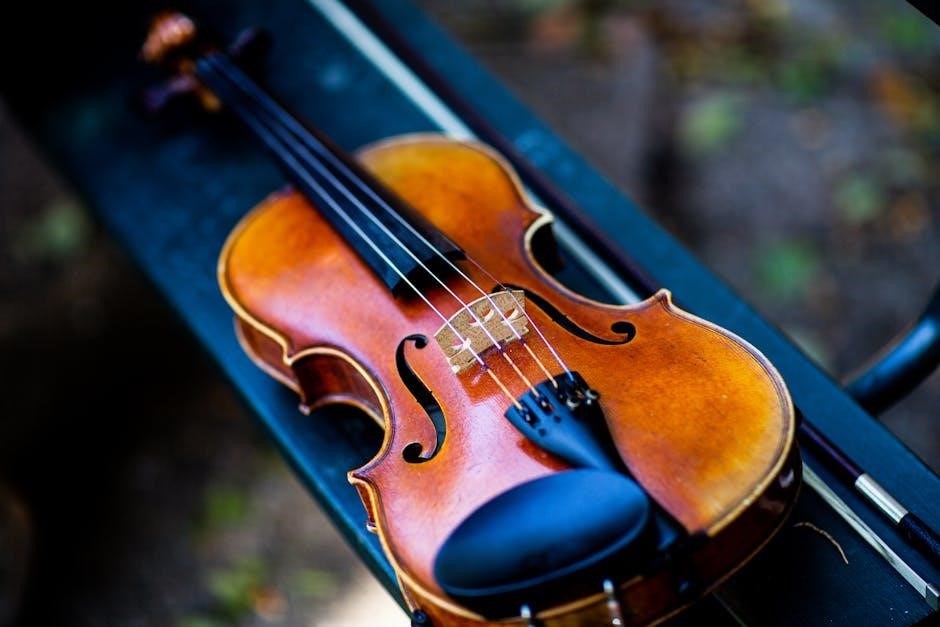The crossword clue “Musical instruction to play very loud” is a popular puzzle question, often appearing in British quick crosswords and other major publications. The answer typically refers to FORTISSIMO, an Italian musical term meaning “very loud.” This clue is frequently sought after by crossword enthusiasts due to its unique combination of musical terminology and puzzle-solving challenge.
1.1 Understanding the Clue
The crossword clue “Musical instruction to play very loud” asks for a term used in music to indicate extreme loudness. This clue is straightforward but requires knowledge of musical terminology. The answer typically sought is FORTISSIMO, an Italian word meaning “very loud,” often abbreviated as ff. It is commonly used in musical notation to direct performers to play at a high volume. The clue’s specificity makes it a fun yet challenging puzzle for both music enthusiasts and crossword solvers, testing their understanding of musical directions and dynamics.
1.2 Relevance of the Topic in Crossword Puzzles
The topic “Musical instruction to play very loud” is a popular crossword clue due to its unique blend of music terminology and puzzle-solving appeal. It frequently appears in crosswords like the British quick crossword and The New York Times, attracting both music enthusiasts and casual solvers. The clue’s specificity makes it challenging yet engaging, as it requires knowledge of musical dynamics. Terms like FORTISSIMO and FORTE are often used, adding variety to crossword themes. This topic’s relevance lies in its ability to combine education with entertainment, making it a staple in many crossword publications.

Possible Solutions to the Crossword Clue
The primary answer to the crossword clue “Musical instruction to play very loud” is fortissimo, an Italian term meaning extremely loud. Other possible solutions include forte, prestissimo, and less commonly, allargando; These terms vary in length and specificity, making them potential fits for different crossword puzzles.
2.1 FORTISSIMO (10 Letters)
FORTISSIMO (abbreviated as ff) is the most common and definitive answer to the crossword clue “Musical instruction to play very loud.” This Italian term, meaning “very loud” or “extremely loud,” is widely used in musical notation to indicate the highest dynamic level. Composed of 10 letters, it fits perfectly into crossword puzzles requiring a longer answer. FORTISSIMO is often used in classical music to direct orchestras, choirs, or soloists to play with maximum intensity, creating a dramatic effect. Its application is universal, making it a frequent solution in music-related crossword clues.
2.2 Other Possible Answers (FORTE, PRESTISSIMO, etc.)
While FORTISSIMO is the most common answer, other terms like FORTE (meaning “loud”) or PRESTISSIMO (combining speed and loudness) may appear. FORTE is shorter, often fitting 5-letter crossword slots, but it signifies “loud” rather than “very loud.” PRESTISSIMO, though less common, refers to an extremely fast and loud tempo. These alternatives are less precise but can still be used depending on the crossword’s context or letter count. However, FORTISSIMO remains the most accurate and frequently sought-after answer for this clue.
Meaning and Origin of the Musical Term
The crossword clue “Musical instruction to play very loud” refers to the term “fortissimo,” meaning very loud in music.
3.1 Definition of “Very Loud” in Music
In music, the term for “very loud” is fortissimo, an Italian word meaning extreme loudness. It is a dynamic marking used to indicate that a piece or section should be played at a high volume. Fortissimo is one of the strongest dynamics, often denoted by ff or fff in musical notation. This instruction guides musicians to produce a powerful sound, adding intensity and emotion to the performance. Understanding such terms is essential for interpreting musical scores and conveying the intended expression accurately.
3.2 Historical Context and Usage
The term fortissimo (abbreviated as ff) has deep roots in musical history, originating from Italian terminology. It gained prominence during the Baroque period as composers sought to express intense emotions through sound. Over time, fortissimo became a standard dynamic marking, used to indicate maximum volume and intensity. Composers like Bach and Beethoven employed it to create dramatic contrasts in their works. Today, fortissimo remains a cornerstone of musical notation, guiding performers to achieve powerful, sonically rich interpretations. Its historical evolution reflects the growing complexity of musical expression, making it a key element in both classical and modern compositions.

Dynamic Markings in Music
Dynamic markings in music guide loudness. Primary terms include piano (p) for soft, forte (f) for loud, and crescendo (cres.) for gradual increase.
4.1 Understanding Musical Dynamics
Musical dynamics refer to the varying degrees of loudness and softness in a piece, guiding performers on intensity. Terms like piano (p) for soft and forte (f) for loud are fundamental. These markings, often in Italian, indicate expression and mood; For instance, crescendo (cres.) signals a gradual increase, while decrescendo (decres.) or diminuendo (dim.) indicates a decrease. Dynamics enhance the emotional depth of music, providing structure and contrast. Understanding these markings is crucial for interpreting compositions accurately, making them a key element in both performance and appreciation.
4.2 Common Dynamic Indicators (Piano, Forte, etc.)
Common dynamic indicators in music include terms like piano (p), meaning soft, and forte (f), meaning loud. These terms, often in Italian, guide performers on volume. Pianissimo (pp) and fortissimo (ff) represent extreme softness and loudness, respectively. Crescendo (cres.) and decrescendo (decres.) indicate gradual changes in volume. These markings help musicians interpret a piece’s emotional intent, providing clarity on how to balance sound. They are essential for achieving the desired mood and expression in musical performances, making them fundamental tools for composers and performers alike.

The Role of “FORTISSIMO” in Music
FORTISSIMO (ff) is an Italian musical term meaning “very loud,” used to indicate a sudden, intense increase in volume. It emphasizes power and intensity in orchestral and choral pieces.
5.1 When and How to Use FORTISSIMO
FORTISSIMO (ff) is used in orchestral and choral music to indicate a dramatic increase in volume, often for climactic or intense moments. Composers typically place it at key points to emphasize power or emotional peaks. It is placed in the score where a sudden, very loud sound is required, often following a crescendo or to contrast with quieter sections. FORTISSIMO is used sparingly to maintain its impact, making it a powerful tool for creating musical tension and release. Famous composers like Beethoven and Mahler frequently incorporated it to enhance dramatic effects in their works.
5.2 Examples in Classical and Modern Music
FORTISSIMO is prominently featured in Beethoven’s Fifth Symphony, where it underscores the dramatic opening motif. In modern music, it’s used in rock ballads and film scores, like in John Williams’ Star Wars themes, to create epic crescendos. Composers like Mahler and Strauss also employed it to heighten emotional intensity in their symphonies. This dynamic marking remains a cornerstone in both classical and contemporary compositions, ensuring a lasting impact on audiences by signaling moments of maximum intensity and grandeur, making it a timeless element in music across genres.

Crossword Clues and Musical Terminology
Crossword clues often incorporate musical terms like FORTISSIMO and FORTE to test solvers’ knowledge of dynamics. These terms are frequently featured in puzzles from the New York Times and LA Times, challenging players to connect musical concepts with wordplay, thus blending art and logic in a unique and engaging way for enthusiasts of both music and crosswords.
6.1 How Crosswords Incorporate Musical Terms
Crosswords often incorporate musical terms to add variety and challenge. Clues like “Musical instruction to play very loud” are designed to test solvers’ knowledge of music terminology. These clues frequently use synonyms or related terms, such as FORTISSIMO or FORTE, to hint at the correct answer. Crossword constructors may also reference classical or modern music, making the puzzles engaging for music enthusiasts. Additionally, the clues might appear in different formats, such as anagrams or cryptic hints, to keep the game exciting. This approach introduces solvers to new musical terms, blending education with entertainment.
6.2 Tips for Solving Music-Related Crossword Clues
When tackling music-related crossword clues, start by recognizing common patterns and terms. Familiarize yourself with musical dynamics like FORTISSIMO and FORTE, which often appear in puzzles. Pay attention to clue wording, as phrases like “very loud” or “softly” are strong indicators of specific terms. Use online resources or musical dictionaries to verify potential answers. Additionally, consider the crossword’s publication, as some, like The New York Times, may use more sophisticated or indirect clues. Practice regularly to build a mental library of musical terminology, making future puzzles easier to solve.

Variations of the Term
The term “musical instruction to play very loud” has variations like FORTISSIMO, FORTE, and PRESTISSIMO, each offering slightly different shades of loudness in musical contexts.
7.1 Italian vs. English Musical Instructions
Italian musical terms dominate loudness instructions, with FORTISSIMO (very loud) being the most common. English instructions are less standardized but sometimes used. Italian terms like FORTE (loud) and PIANISSIMO (very soft) are universally adopted. This distinction aids crossword solvers, as Italian terms are more likely answers due to their prevalence in musical notation. Understanding this cultural difference helps in identifying the correct term for “very loud,” especially when crossword clues specify letter counts or languages. This knowledge enhances both musical appreciation and crossword-solving skills.
7.2 Less Common Terms for Loudness
Beyond FORTISSIMO, less common terms for loudness exist, offering variety in musical notation. PRESTISSIMO combines speed and loudness, while ALLARGANDO suggests a gradual increase in volume. SONORO emphasizes a rich, loud tone. These terms are rarely used in crosswords but can appear in challenging puzzles. Knowing them broadens one’s understanding of musical dynamics and enhances crossword-solving abilities. These obscure terms add depth to music and intrigue to puzzles, making them valuable for enthusiasts seeking to expand their knowledge beyond the standard terms.

The Use of “Very Loud” in Different Musical Contexts
The instruction to play very loud is widely used in orchestral music to emphasize dramatic moments. It also appears in vocal performances to highlight emotional peaks. Additionally, it is common in rock and pop music to create powerful climaxes, making it a versatile dynamic indicator across genres.
8.1 Orchestral Music
In orchestral music, the instruction to play very loud is often denoted by terms like fortissimo (abbreviated as ff) or fortississimo (fff). These markings are used to create dramatic contrasts and emphasize key themes or climactic moments. For instance, in symphonies by Beethoven or operas by Verdi, fortissimo sections are employed to build intensity and convey powerful emotions. Conductors carefully balance these dynamics to ensure the orchestra achieves the desired sonic impact without overwhelming the ensemble. This technique is essential for shaping the narrative and emotional depth of orchestral compositions, making it a cornerstone of classical music performance.
8.2 Vocal Performances
In vocal performances, the instruction to play very loud is crucial for dramatic expression. Terms like fortissimo are used to direct singers or choirs to project their voices powerfully, often in operas or musicals. For example, in Verdi’s operas, fortissimo passages are used to convey intense emotions, while in contemporary musicals, they highlight climactic moments. Vocalists must balance volume with precision to avoid strain, ensuring clarity even at high decibel levels. This dynamic marking enhances the emotional impact of a performance, making it a key element in both classical and modern vocal repertoire.

Solving the Crossword: Step-by-Step Guide
To solve the crossword clue, start by identifying the type of clue. Recognize that “musical instruction to play very loud” points to a specific musical term. Recall that “fortissimo” is the Italian term for “very loud.” Next, consider the letter count and ensure it fits the grid. Confirm by checking reliable sources or musical terminology guides. This systematic approach will lead you to the correct answer efficiently.
9.1 Identifying the Clue Type
Identifying the clue type is crucial for solving the crossword. The phrase “musical instruction to play very loud” indicates a definition-based clue. It directly points to a specific musical term. Crossword clues often frame terms in a straightforward manner, making it essential to recognize the context. Understanding that this clue relates to musical dynamics helps narrow down the possibilities. By categorizing the clue as a definition clue, solvers can focus on musical terminology, leading them to the correct answer, such as fortissimo, which fits the description of playing very loud. This step is foundational for efficient solving.
9.2 Narrowing Down Possible Answers
Narrowing down possible answers for the crossword clue “Musical instruction to play very loud” involves focusing on musical terminology related to dynamics. The most likely term is fortissimo, an Italian word meaning “very loud,” often abbreviated as “ff” in sheet music. Given that the clue specifies “very loud,” shorter terms like forte (loud) are less likely. Additionally, considering the typical length of crossword answers, fortissimo fits well as a 10-letter word. Other possibilities like prestissimo refer more to tempo than loudness, making fortissimo the most accurate choice.

Common Mistakes in Answering the Clue
A common mistake is confusing fortissimo with similar terms like forte or prestissimo. Misinterpreting the clue’s focus on loudness rather than tempo can also lead to errors.
10.1 Misinterpretation of the Term
A common mistake is misinterpreting the term as relating to tempo rather than volume. Many confuse fortissimo with prestissimo (very fast) or pianissimo (very soft). Others may overlook the Italian origin, mistaking it for a tempo marking. Some assume it’s a combination of forte and another term. Additionally, the abbreviation “ff” for fortissimo is often misunderstood. These errors stem from the complexity of musical terminology and the similarity of related terms, leading to incorrect answers in crosswords.
10.2 Confusing Similar Terms
Several terms similar to fortissimo often confuse crossword solvers. Prestissimo (very fast) and forte (loud) are commonly mixed up. Some mistake fortissimo for pianissimo (very soft) due to their contrasting meanings. Others confuse it with mezzo-forte (moderately loud). The Italian origin adds complexity, leading to mix-ups with terms like allargando (slowing down). Additionally, terms like ff (fortissimo abbreviation) and fz (forzando) are often misunderstood, causing further confusion in solving the crossword clue.

Resources for Further Learning
For deeper understanding, explore musical terminology guides and crossword solving strategies. Websites like Ultimate Crossword Solver and Musical Terms Dictionary offer extensive resources and tips.
11.1 Musical Terminology Guides
Musical terminology guides are essential for understanding terms like FORTISSIMO, which means “very loud.” These guides provide detailed explanations of musical instructions, dynamics, and their historical contexts. Websites like Ultimate Crossword Solver and Musical Terms Dictionary offer comprehensive lists of musical terms, aiding both crossword enthusiasts and music learners. They often include examples from classical and modern music, making complex terms more accessible. By consulting these resources, one can gain a deeper understanding of musical language and improve their crossword-solving skills. These guides are invaluable for anyone seeking to master musical terminology.
11.2 Crossword Solving Strategies
Mastering crossword solving strategies is key to tackling clues like “Musical instruction to play very loud.” Start by analyzing the clue type, whether it’s a definition, synonym, or anagram. Use word lists and pattern recognition to identify potential answers. Crossword solvers often benefit from reversing letters or considering less common terms. Online tools like Ultimate Crossword Solver can provide instant answers, while practice and familiarity with musical terminology will enhance your skills. Combining logic with knowledge of musical terms like FORTISSIMO or FORTE can help you solve clues efficiently. Regular practice and learning from past puzzles are essential for improvement.
The crossword clue “Musical instruction to play very loud” primarily points to FORTISSIMO, an Italian term meaning “very loud.” This clue is both challenging and educational, introducing solvers to musical terminology while enhancing their problem-solving skills. Exploring such clues encourages a deeper appreciation of music and crosswords alike.
12.1 Summary of Key Points
The crossword clue “Musical instruction to play very loud” is commonly solved with FORTISSIMO, an Italian term meaning “very loud.” This clue often appears in British quick crosswords and other publications, challenging solvers to connect musical terminology with wordplay. FORTISSIMO is frequently highlighted as the primary answer due to its specificity and relevance in musical dynamics. The clue not only tests knowledge of music terms but also enhances problem-solving skills, making it a popular and educational puzzle question for enthusiasts.
12.2 Encouragement for Further Exploration
Exploring the world of crossword clues like “Musical instruction to play very loud” can be a rewarding journey, combining music theory with wordplay. By delving deeper, you’ll discover more about musical dynamics and terminology, enhancing both your puzzle-solving skills and appreciation for music. Experiment with crosswords featuring musical themes and explore resources like FORTISSIMO guides to broaden your knowledge. Embrace the challenge of learning new terms and their meanings, as it can open doors to a richer understanding of both music and language.


